
|
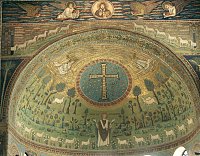
|
The basilica ends in a semi-circular apse. Mosaic decoration covers both it and the triumphal arch. The mosaics of the apse are dated before the middle of the 6th century whereas the mosaics on the arch date between the 6th and 12th centuries. |
| |
|
| In the lower part of the apse Saint Apollinare is depicted in the center of a green landscape. Saint Apollinare, the first bishop of Ravenna, is robed in a white dalmatic and purple tunic, embroidered with bees, symbolizing eloquence. He is in the early Christian "orant" position--with outstretched arms praying. Twelve lambs are at his feet, symbolizing the community of the faithful. This figure also symbolically recalls Christ as the Good Shepherd, with the twelve sheep then representing Christ's Disciples. |

|

|
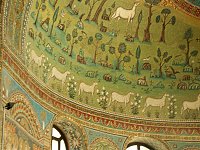
|
| |
|
ParadiseA paradisal landscape is depicted in this lower region of the apse with a meadow filled with trees, bushes, flowers, rocks, and birds. |
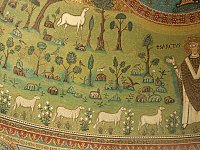
|
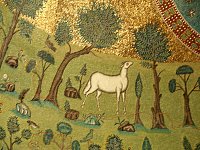
|
| |
|
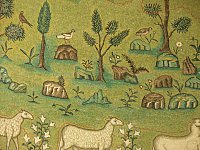
|
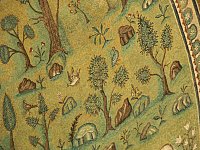
|
Realism and stylizationElements of the landscape are isolated and arranged symmetrically and no attempt is made to depict deep natural space. |
| |
|
The upper zone: the TransfigurationThe upper zone in the apse mosaic depicts the Transfiguration of Christ on Mount Tabor in a symbolic way. This moment, when Christ's divine nature was manifested to his disciples Peter, James, and John, is represented symbolically, with three rapt sheep facing the jewelled cross. |
| God's hand is seen in the stylized clouds. Like the symbolic sheep, Christ is not represented as a man but is represented symbolically as a great cross. This jewelled cross floats in a star-spangled sky with Christ's face barely visible in the pearl frame in the center. |

|
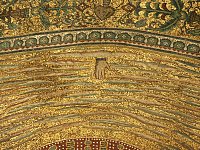
|
| |
|
The jewelled crossAt the top of the cross the Greek word for fish appears, an acrostic formed by the initials of five Greek words meaning "Jesus Christ, Son of God, the Savior." The alpha and omega appear at the sides--the last letters of the Greek alphabet, used symbolically by Christ in the Apocalypse to signify that he was the beginning and the end. Below the cross are the words Salus Mundi, Salvation of the World. Rather than depicting an event narrated in the Bible, this mosaic indicates important theological and symbolic ideas. |

|
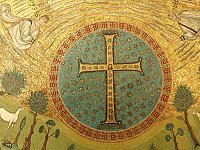
| Half-length figures of Moses and Elijah, two great prophets and representatives of the Old Testament, emerge from the clouds. See details below. |
| |
|
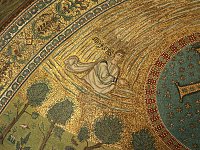
|
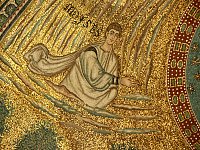
|
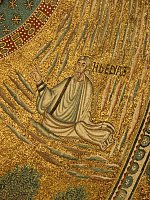
|
| |
|
Mosaics of the Triumphal archThe chronology of the arch mosaics is debated, with dates for their execution varying from the 6th to the 12th century. |

|
Dated to the 9th century, the upper register here depicts a bust of a bearded Christ giving a blessing. On each side on a blue background with clouds are the four symbols for the Evangelists, winged figures holding books--the eagle (John), angel (Matthew), lion (Mark) and the ox (Luke). |
| |
|
Sheep marching toward ChristDated to the 7th century, the scene below depicts twelve white sheep, symbolizing the Apostles, emerging from the doors of two holy cities--Jerusalem and Bethlehem, respectively the Jewish and Gentile churches. |

|
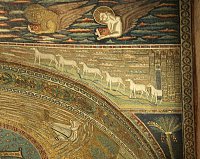
|
| |
|
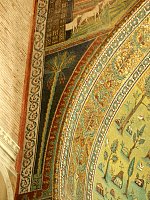
|
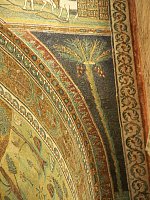
|
The date palmsYet a lower zone, dated to the 7th century, depicts two palm trees, recalling the verse of the psalm "the just man will flower like the palm." |
| |
|
The lowest register on the triumphal arch: Archangels Michael and GabrielBoth angels are shown as celestial guards, dressed in robes recalling formal ceremonies. They are shown against the typical golden ground of Byzantine mosaics and are sometimes dated as early as the 6th century. |
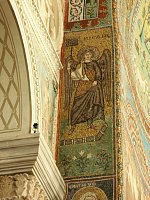
|
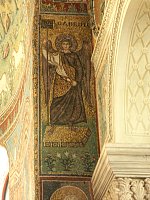
|


 Click here to return to index of art historical sites.
Click here to return to index of art historical sites.
 Click here to return to index of artists and architects.
Click here to return to index of artists and architects.
 Click here to return to chronological index.
Click here to return to chronological index.
 Click here to see the home page of Bluffton University.
Click here to see the home page of Bluffton University.

